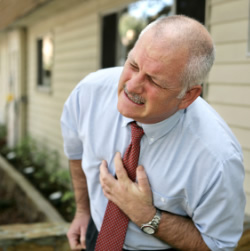Air Pollution is “an overlooked risk factor” for Heart Disease
 Over the last decade we've seen plenty of studies linking air pollution, and specifically Particulate Matter, or soot pollution, to heart disease and attacks. Now Dr. François Reeves,a Canandian cardiologist has a new book "Planet Heart: How an Unhealthy Environment Leads to Heart Disease," that puts those studies in context.
Over the last decade we've seen plenty of studies linking air pollution, and specifically Particulate Matter, or soot pollution, to heart disease and attacks. Now Dr. François Reeves,a Canandian cardiologist has a new book "Planet Heart: How an Unhealthy Environment Leads to Heart Disease," that puts those studies in context.
“You can sum it up like this: more pollution, more major adverse cardiac events. Pollution of the city is as toxic as cigarette smoke. It has different stuff in it, but the difference is that with pollution, you get it all through your life, from your birth to your death. If you live in a polluted milieu, as soon as you’re a baby you’ll take it in through every breath.”
Reeves' interest as a cardiologist in air pollution issues was triggered by a 2008 World Health Organization report that tracked mortality rates for cardiovascular disease in European countries. In nations with relatively clean air like Norway or even France, the levels were approximately 25 to 70 per 100,000 men. In Russia and the Ukraine it was 600-750 per 100,000. “I was blown away by those numbers,” Reeves says. “We know the classical and well-demonstrated risk factors for heart disease, like smoking and obesity and inactivity. But that’s when I realized the environment has a huge impact."
Just like lead, and benzene, and dioxin, and so many other kinds of pollution, there appears to be no "safe level" of exposure to PM pollution. Any amount is capable of doing some harm, and the more you're exposed, the more harm is likely to happen. That's why fence-line communities are particularly vulnerable to higher rates of illness. In DFW, where PM levels are considered under control, there are still lots of hot spots for the pollutant. If you live downwind of the Midlothian cement plants, you're inhaling a lot of soot. the closer you live – Cedar Hill, South Grand Prairie, South Arlington, Mansfield – the more soot you're inhaling.
In his new book Reeves gives a list of heart-healthy things an individual can do to reduce their risk of heart disease, including increased bike riding, more public transit, or walking and weaning yourself off of internal combustion engines with electric cars and hybrids. “Look at everything you’re doing to minimize your footprint and do whatever you can to have an impact on global footprint,” Reeves says,
But he recognizes the limits of this kind of advice if a person is living in a smoggy city or region and offers overarching policy advice for officials. Cities and governments must continue their efforts to be green, if only out of their own self-interest.
If those governments need any convincing, Brauer points to a financial argument: fewer health problems mean less strain on the public system. “If you improve air quality, everybody benefits,” he says. “It’s really, really cost-effective.
